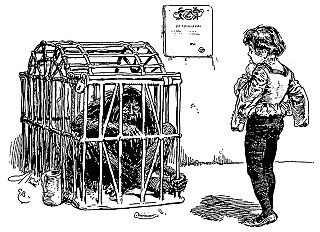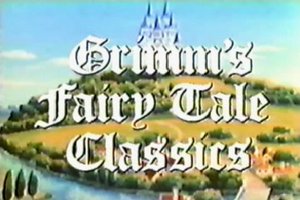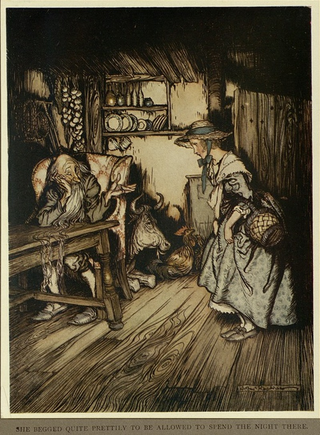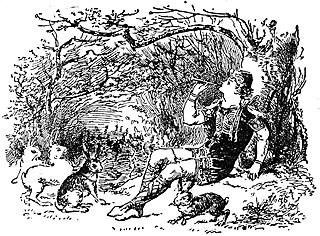| The Griffin | |
|---|---|
| Folk tale | |
| Name | The Griffin |
| Aarne–Thompson grouping | ATU 610; ATU 461 |
| Country | Germany |
| Published in | Grimms' Fairy Tales |
"The Griffin" is a German fairy tale collected by the Brothers Grimm in Grimm's Fairy Tales (KHM 165). [1] [2]
It is Aarne-Thompson type 610, Fruit to Cure the Princess; and type 461, Three Hairs from the Devil. [3] The Brothers Grimm noted its similarity to The Devil With the Three Golden Hairs . [1]
The opening type is seldom a stand-alone tale; it combines with others, such as type 461, as in this, or type 570, the Rabbit Herd, as in The Three May Peaches , to form a complete tale. [4] The opening also features in Jesper Who Herded the Hares .
"The Griffin" under the German title "Der Vogel Greif" first appeared in the third edition of Grimm's Fairy Tales (1837), supplied to the Brothers Grimm by Wilhelm Wackernagel. It was written down in Swiss dialect (Alemannic) from the oral tale told by Freidrich Schmidt. [5] [6] The correct Alemannic title was "Vogel Gryf", as in the printed text by Otto Sutermeister (1873). [5] [7]
A king's daughter was ill, and it was foretold she would be made well by eating an apple. The king declared that whoever brought the apple to cure her would marry her. A peasant with three sons sent the oldest, Uele, with a basket of apples. On his journey, the boy met an iron man who asked him what was in the basket. The boy answering "Frogs' legs", the iron man made it so. When Uele reached the king, the basket did contain frogs' legs and the king drove him out.
The peasant then sent his second son, Seame, who encountered the iron man, answering "Hogs' bristles", and making the same discovery as his older brother and receiving the same reception.
The youngest son, Hans, who was rather a fool, begged to go until his father finally agreed. When Hans met the iron man, he said the basket contained the apples which the princess would eat to make herself well. The iron man said that it was so. The basket held apples when he reached the castle, and the princess was cured.
The king, however, refused to let them marry until he had a boat that traveled over dry land and sea. Hans went home and told his father. His father sent Uele to the forest to make such a ship; the iron man came to him and asked what he was making; when Uele said "Wooden bowls" that was what he made. Seame suffered the same fate, but when Hans told the iron man he was making a ship that would travel over land and sea, he made such a boat.
The king set Hans to catch a hundred hares in a meadow in one day. Hans did so, not losing any. The king sent a maid to beg one from him, for guests. Hans refused it, but said he would give one to the king's daughter. Then the iron man gave him a whistle that would summon any hare back. Hans gave the king's daughter a hare but then whistled it back.
The king sent Hans to fetch him a feather from the griffin's tail. On the way, a lord of a castle asked him to ask the griffin where was the lost key to his money chest; another lord, how their ill daughter could be cured; a giant, why he had to carry people over a lake. At the griffin's castle, he met the griffin's wife, who warned him that the griffin would eat him, but at night, he could pull out a feather, and then she would get the answers for him.
Hans did as she said, and when he pulled the feather, the griffin woke. The wife told him that a man had been there and gone away, but told her some stories first. She repeated them, and the griffin said that the key was in the wood house, under a log; that a toad had made a nest of the daughter's hair, but she would recover if they took the hair out; that the giant had only to put someone down in the middle of the lake and he would be free. Hans left and told the other lords what he had learned; they gave him rich treasures. When he reached the king, he claimed the griffin had given them. The king set out to get some, but he was the first man to reach the giant, who put him down in the lake, where he drowned. Hans married the princess and became king.
Elements from the story feature in the episode "The Luck Child" from Jim Henson's The Storyteller .

"Iron John" is a German fairy tale found in the collections of the Brothers Grimm, tale number 136, about an iron-skinned wild man and a prince. The original German title is Eisenhans, a compound of Eisen "iron" and Hans. It represents Aarne–Thompson type 502, "The wild man as a helper".

Grimm's Fairy Tale Classics, also known as Grimm Masterpiece Theater in the original version and The Grimm's Fairy Tales, is a Japanese anime anthology series by Nippon Animation based on the Grimms' Fairy Tales.

"The Goose Girl" is a German fairy tale collected by the Brothers Grimm and first published in Grimm's Fairy Tales in 1815. It is of Aarne-Thompson type 533.

Grimms' Fairy Tales, originally known as the Children's and Household Tales, is a German collection of fairy tales by the Brothers Grimm, Jacob and Wilhelm, first published on 20 December 1812. Vol. 1 of the first edition contained 86 stories, which were followed by 70 more tales, numbered consecutively, in the 1st edition, Vol. 2, in 1815. By the seventh edition in 1857, the corpus of tales had expanded to 200 tales and 10 "Children's Legends". It is listed by UNESCO in its Memory of the World Registry.

"The Golden Bird" is a fairy tale collected by the Brothers Grimm about the pursuit of a golden bird by a gardener's three sons.

"The Singing, Springing Lark", "The Singing, Soaring Lark", "The Lady and the Lion" or "Lily and the Lion" is a German fairy tale collected by the Brothers Grimm, appearing as tale no. 88.
Farmer Weathersky is a Norwegian fairy tale collected by Peter Chr. Asbjørnsen and Jørgen Moe in Norske Folkeeventyr.

The Iron Stove is a fairy tale collected by the Brothers Grimm, as tale number 127. It is Aarne–Thompson type 425A, "The Animal (Monster) as Bridegroom". Dorothea Viehmann prepared the story for the Grimms' collection.

"The Hut in the Forest" is a German fairy tale collected by the Brothers Grimm. Andrew Lang included it in The Pink Fairy Book (1897). It is Aarne-Thompson type 431.
"The Three Little Birds" is a German fairy tale collected by the Brothers Grimm, tale number 96. The story is originally written in Low German. It is Aarne-Thompson type 707, the dancing water, the singing apple, and the speaking bird. The story resembles Ancilotto, King of Provino, by Giovanni Francesco Straparola, and The Sisters Envious of Their Cadette, the story of the 756th night of the Arabian Nights.

"Donkey Cabbages" is a German fairy tale collected by the Brothers Grimm, tale number 122. A man shoots birds in a forest and gains magical objects. By also ingesting the heart of one of the birds he shot, he acquires an inexhaustible source of wealth. Later on, his magical abilities and items are stolen by a trio of witches, but he regains everything thanks to a magical herb that causes one to transform into a donkey.

"The Water of Life" is a German fairy tale collected by the Brothers Grimm, tale number 97.
The Three Dogs is a German fairy tale. Andrew Lang included it in The Green Fairy Book, listing his source as the Brothers Grimm. A version of this tale appears in A Book of Dragons by Ruth Manning-Sanders.
"The Brown Bear of the Green Glen" is a Scottish fairy tale collected by John Francis Campbell in Popular Tales of the West Highlands, listing his informant as John MacDonald, a "Traveling Tinker". He also noted the parallels with The Water of Life.

The King of England and his Three Sons is a Romani fairy tale collected by Joseph Jacobs in More English Fairy Tales. He listed as his source Francis Hindes Groome's In Gypsy Tents, where the informant was John Roberts, a Welsh Roma. Groome published the tale as An Old King and his three Sons in England.
"The Bold Knight, the Apples of Youth, and the Water of Life" is a Russian fairy tale collected by Alexander Afanasyev in Narodnye russkie skazki. The tale and is variants are numbered 171-178 in the first volume of the three-volume collection.
Făt-Frumos with the Golden Hair or The Foundling Prince is a Romanian fairy tale collected by Petre Ispirescu in Legende sau basmele românilor.
The Three May Peaches is a French fairy tale collected by Paul Delarue. He collected more than thirty French types of this tale, which is known in Europe, North Africa, and Asia as far as India.

Jesper Who Herded the Hares is a Scandinavian fairy tale, first recorded by Danish folktale collector Evald Tang Kristensen in the first volume of Æventyr fra Jylland. Andrew Lang included it in The Violet Fairy Book.

"The Gnome" is a German fairy tale collected by the Brothers Grimm in Grimm's Fairy Tales, tale number 91.